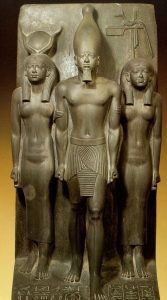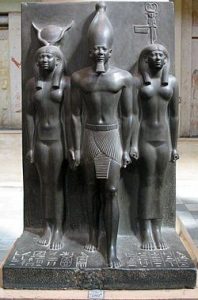The meaning of ‘triad’
Triad refers to a group of three figures. In ancient Egypt, there were a number of triads. These triads mostly consist of gods and goddesses; sometimes also significant kings. So, the ‘Triad of Menkaure’ was one of them.
Who was Menkaure?
Menkaure was a pharaoh. He ruled in ancient Egypt during the time period of the fourth dynasty. This dynasty belonged to the Old Kingdom. Among the three famous pyramids of the Giza complex, one belongs to Menkaure. People call it the ‘Pyramid of Menkaure’.
Triad of Menkaure: Origin
Triad of Menkaure is a form of a triad. It mainly reflects the deification of the pharaoh Menkaure. There are different forms of this triad. In every form, Menkaure is accompanied by Goddess Hathor. The third one in the triad changes according to the different forms.
Archaeologists recovered these three forms of triads from the region of eastern desert and Sinai of modern Egypt. These sculptures are made out of greywacke and schist.
The different forms of the Triad
The three different sculptural forms are equally significant in the terms of their appearance, style etc. The first form of the triad is significant because it represents the personification of the 17th nome of Upper Egypt. The term ‘nome’ in ancient Egypt referred to every specific region. There were a number of nomes in ancient Egypt.

The second form of the triad is important as it showcases the representation of the personification of the 4th nome of Upper Egypt. The Third form, on the other hand, represents the personification of the 7th nome of Upper Egypt. Thus one thing we can clearly understand. It is that the pharaoh Menkaure had probably a stronghold on these three nomes.
The representation of the pharaoh
In every sculptural form of the triad, the pharaoh is placed in the middle position. As it denotes his supreme authority. He wears the White crown of Upper Egypt and a false beard. Both of these attributes are important. Because they denote the royal power.

The representation of the Goddess Hathor
Goddess Hathor is always placed on the right side of the pharaoh. She wears her traditional Hathoric wig. There is also a solar disk along with two cow horns. The posture of this important goddess indicates that the pharaoh placed himself to a divine position associated with her. It also indicated that this particular goddess won massive respect during the reign of Menkaure. Thus he might use her as a way to authorize his divine royalty through the idea of originating a triad with her.

The representation of different nomes
In every form, the deity on the left of the pharaoh represents a specific nome of the then Upper Egypt. In the first and the second form, female deities represent the personification of the 17th and the 7th nomes respectively. But the second form is totally different in this aspect. because it has a male deity representing the 4th nome.
